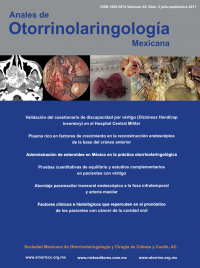An Orl Mex. 2017 jul;62(3):172-181.
Said-Martínez J
Práctica privada, Ciudad de México.
Resumen
ANTECEDENTES: el sistema de generación del nistagmo o el sistema vestibular central inician en la célula nerviosa periférica o la primera neurona del ganglio, se extiende a la zona nodular y flocular para informar al cerebro. Por las características neuro-oto-fisiológicas se requieren estudios cuantitativos que determinen el topo-diagnóstico del paciente con vértigo.
OBJETIVO: investigar la función vestibular a través de las pruebas cuantitativas: craneocorpografía (CCG), posturografía (TOB), electronistagmografía computada (GNC), prueba rotatoria (RIT) y la ultrasonografía Doppler de cabeza y cuello (USD) en el paciente con vértigo, describiendo resultados en grupos de pacientes en Alemania, Argentina y México.
MATERIAL Y MÉTODO: estudio retrospectivo en el que se incluyeron pacientes con vértigo, a quienes se realizaron estudios vestíbulo-espinal (CCG) y (TOB), retino-ocular y vestíbulo-ocular (GNC) y de la circulación vascular cerebral ultrasonografía Doppler, bajo los parámetros de Alemania (10,335 pacientes) y Argentina (2234 pacientes).
RESULTADOS: se incluyeron 1343 pacientes con vértigo (860 mujeres y 483 varones), 48.1% de los casos tenían origen vascular. El síntoma vértigo representó 99% en el grupo de México, Alemania y Argentina; al aplicar pruebas cuantitativas se obtuvieron resultados topo-diagnósticos.
CONCLUSIONES: después de haber realizado las pruebas cuantitativas de la función vestibular del sistema vestíbulo espinal se determinó un diagnóstico específico.
PALABRAS CLAVE: vértigo, craneocorpografía, posturografía, electronistagmografía, prueba rotatoria, ultrasonografía Doppler de cabeza y cuello.
Quantitative tests of balance and complementary studies in patients with vertigo.
An Orl Mex. 2017 July;62(3):172-181.
Said-Martínez J
Práctica privada, Ciudad de México.
Abstract
BACKGROUND: The system of nystagmus generation or central vestibular system starts in the peripheral nerve cell or the first neuron of the ganglion, extends to the nodular and flocular area to inform the brain. Due to this neurootophysiology quantitative studies are required that determine the topodiagnosis of the patient with vertigo.
OBJECTIVE: To investigate vestibular function through quantitative tests: craniocorpography (CCG), posturography (TOB), computed electronystagmography (CNG), rotary test (RIT) and Doppler ultrasonography head and neck (USD) in the patient with vertigo, describing results in patient groups in Germany, Argentina and Mexico.
MATERIAL AND METHOD: A retrospective study in which patients with vertigo were studied through the vestibulospinal (CCG) and (TOB), retinoocular and vestibular (CNG) and cerebral vascular circulation studies USD Doppler ultrasonography, under the parameters of Germany (10,335 patients) and Argentina (2234 patients).
RESULTS: There were included 1343 patients with vertigo (860 women and 483 men), 48.16% of cases had a vascular origin. The vertigo symptom affected 99%, in the group of Mexico, Germany and Argentina, when applying quantitative tests topodiagnostic results were obtained in the different groups studied.
CONCLUSIONS: After having performed the quantitative tests of the vestibular function of the vestibulospinal system it was determined the specific diagnosis.
KEYWORDS: vertigo; craniocorpography; posturography; computerized electronystagmography; rotating test; Doppler ultrasound; head and neck


